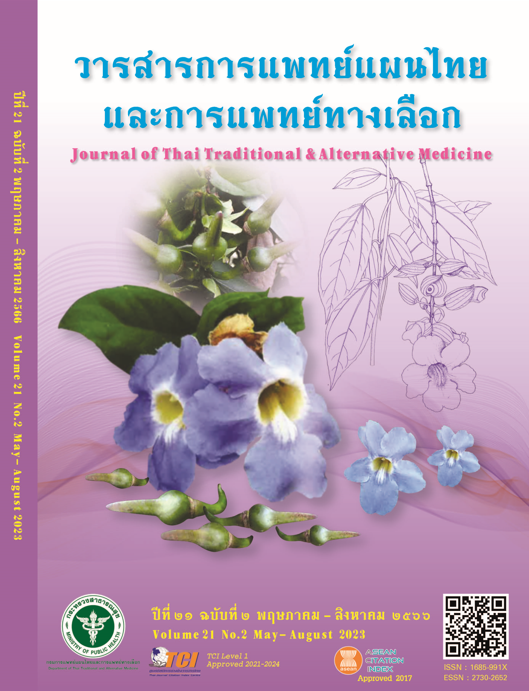Development and Method Validation of Friedelin Contents in Cannabis sativa L. Roots Using Thin Layer Chromatography Densitometry
Main Article Content
Abstract
Introduction and objective: Friedelin is an active ingredient present in Cannabis sativa L. roots and possesses antioxidant, anti-inflammatory and pain relief properties. Although cannabis is widely used in traditional medicine and as health products, there is no quality control method for it. The objective of this study was to develop an analytical method for determining the friedelin content in C. sativa roots using thin layer chromatography (TLC) densitometry.
Methods: A sample solution of C. sativa roots was injected into the TLC system. The solvent was a mixture of toluene and chloroform (9:1 ratio). After that, the plate was sprayed with vanillin-H2SO4 solution and detected with ultraviolet light (366 nm).
Results: This method was validated by establishing the linearity for friedelin concentrations ranging from 25.99 to 831.60 µg/mL with a determination correlation coefficient (r) of 0.9990. The % recovery was in the range of 100.57–102.45%. The limits of detection and quantitation were equal to 0.006% and 0.021% w/w (dry weight C. sativa roots, µg/µg), respectively. The average content of friedelin in C. sativa roots was 0.025% w/w (dry weight C. sativa roots, µg/µg).
Discussion: In extracting C. sativa roots, hexane was chosen as a solvent because it has high nonpolar properties; and it is able to dissolve more friedelin, a substance with nonpolar properties as well, from the C. sativa roots, compared to ethanol extraction. In the newly developed analytical method, the stationary cycle used was HPTLC plates, which were cheaper, compared to the columns of the GC-MS/FID method. Thus, a TLC dosimeter was used to develop the method for determining the amount of friedelin in C. sativa roots.
Conclusion and recommendation: This newly developed method is suitable and can be used to analyze the content of friedelin in C. sativa roots; and the appropriate specification of friedelin content in C. sativa roots can be established.
Article Details

This work is licensed under a Creative Commons Attribution-NonCommercial-NoDerivatives 4.0 International License.
References
Boonyaprapat N, Chokchaicharoenporn O. Medicinal plants indigenous to Thailand. Bangkok: Prachachon; 1996. 1(1): p. 169. (in Thai)
Ryz NR, Remillard DJ, Russo EB. Cannabis roots: A traditional therapy with future potential for treating inflammation and pain. Cannabis Cannabinoid Res. 2017;2(1):210-6.
Abhimanyu KK, Ravindra CS, Avanapu RS. A validated HPTLC method for the quantification of friedelin in Putranjiva roxburghii Wall extracts and in polyherbal formulations. Bulletin of Faculty of Pharmacy, Cairo University. 2017;55(1):79-84.
Kornpointner C, Martinez AS, Marinovic S, Haselmair-Gosch C, Jamnik P, Schroder K, Lofke C, Halbwirth H. Chemical composition and antioxidant potential of Cannabis sativa L. roots. Industrial Crops and Products. 2021;165:113422.
Department of Medical Sciences, Ministry of Public Health. Thai Herbal Pharmacopoeia 2018. Bangkok: Keawjawjom Printing & Publishing SuanSunandhaRajabhat University; 2018.
Department of Medical Sciences. A practical guide for single laboratory method validation of chemical methods. Nonthaburi: Department of Medical Sciences; 2006. (in Thai)


